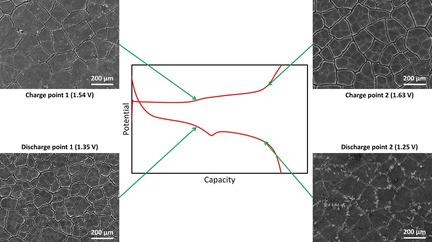当前位置:
X-MOL 学术
›
Batteries Supercaps
›
论文详情
Our official English website, www.x-mol.net, welcomes your feedback! (Note: you will need to create a separate account there.)
Electrodeposited Manganese Oxide on Carbon Paper for Zinc‐Ion Battery Cathodes
Batteries & Supercaps ( IF 5.7 ) Pub Date : 2019-12-27 , DOI: 10.1002/batt.201900150 Arjun Dhiman 1 , Douglas G. Ivey 1
Batteries & Supercaps ( IF 5.7 ) Pub Date : 2019-12-27 , DOI: 10.1002/batt.201900150 Arjun Dhiman 1 , Douglas G. Ivey 1
Affiliation

|
Nano‐crystalline, flake‐like Mn oxide was electrodeposited onto carbon paper (CP) using a pulsed electrodeposition technique. The electrodeposited Mn oxide was identified as Mn3O4 through a combination of X‐ray photoelectron spectroscopy (XPS), X‐ray diffraction (XRD), and Raman spectroscopy. The Mn3O4 on CP was used as a cathode for Zn‐ion batteries (ZIBs) and showed excellent cyclability at a current density of 1 A g−1 with a capacity retention of 139 % after 200 cycles. Electron microscopy was used to characterize the microstructural changes of the cathode at various stages during discharge/charge cycling. This work in combination with the electrochemical results suggests a two‐step reaction mechanism involving both intercalation and conversion reactions. The results demonstrate that electrodeposition of the cathode material is a simple, quick, and potentially scalable electrode synthesis method for producing high performing Zn‐ion electrodes without the use of binders or other additives.
中文翻译:

用于锌离子电池阴极的碳纸上的电沉积锰氧化物
使用脉冲电沉积技术将纳米晶状片状Mn氧化物电沉积到复写纸(CP)上。通过X射线光电子能谱(XPS),X射线衍射(XRD)和拉曼光谱的组合将电沉积的Mn氧化物鉴定为Mn 3 O 4。CP上的Mn 3 O 4用作Zn离子电池(ZIBs)的阴极,在1 A g -1的电流密度下显示出出色的循环能力200次循环后的容量保留率为139%。电子显微镜被用来表征在放电/充电循环期间各个阶段的阴极的微观结构变化。这项工作与电化学结果相结合,提出了涉及插层和转化反应的两步反应机理。结果表明,阴极材料的电沉积是一种无需使用粘合剂或其他添加剂即可生产高性能Zn离子电极的简单,快速且潜在可扩展的电极合成方法。
更新日期:2019-12-27
中文翻译:

用于锌离子电池阴极的碳纸上的电沉积锰氧化物
使用脉冲电沉积技术将纳米晶状片状Mn氧化物电沉积到复写纸(CP)上。通过X射线光电子能谱(XPS),X射线衍射(XRD)和拉曼光谱的组合将电沉积的Mn氧化物鉴定为Mn 3 O 4。CP上的Mn 3 O 4用作Zn离子电池(ZIBs)的阴极,在1 A g -1的电流密度下显示出出色的循环能力200次循环后的容量保留率为139%。电子显微镜被用来表征在放电/充电循环期间各个阶段的阴极的微观结构变化。这项工作与电化学结果相结合,提出了涉及插层和转化反应的两步反应机理。结果表明,阴极材料的电沉积是一种无需使用粘合剂或其他添加剂即可生产高性能Zn离子电极的简单,快速且潜在可扩展的电极合成方法。


























 京公网安备 11010802027423号
京公网安备 11010802027423号